
Chapter 8
The background to creating an ebusiness
Using a cafe to explore opportunities
A cafe used to explore new business opportunities in a solution space is conceptually different from a cafe that might be used to write books, accumulate contacts or run an established business. However, the interactions in such a cafe are not easy to explain because so much of the activity is dynamic and in the mind.
Any easily understandable description has to be based around particular incidents or moments in time. This doesn't quite do justice to the fast changing complexity of the many different interactions that occur in the conceptual space of a virtual cafe – where so many thoughts, ideas, approaches, dialogues and actions are continuously being explored and, more often than not, abandoned at an early stage.
Perhaps it is more easily described by way of an animated diagram. Such a diagram emerged out of a correspondence I had with Dr. Thomas Thum, from Munich, Germany. Dr. Thum has an engineering consultancy business that helps companies in the chemical and food processing industries to design and optimise manufacturing and logical processes. His work involves mathematical modelling and the design of simulation software.
In an effort to understand the virtual cafe, Dr. Thum wrote a Java applet that provided an animated demonstration as to how he visualised the cafe working. His first demo is on his Web site at:
http://www.thomas-thum.de/evolutionary-strategy-1.htm.
The essence of this animated simulation is shown in figures 8.4 and 8.5, where the screen opens to a space containing fifty dots to represent people in the cafe.
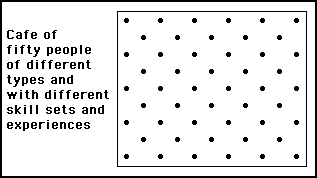
Figure 8.4
Cafe represented as a space containing fifty dots
Upon clicking a start button, the dots (people) move towards a project with the animation causing the dots to move randomly around in the vicinity of the project to signify the people in the cafe working on the project together. This is illustrated in figure 8.5.
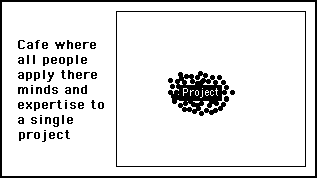
Figure 8.5
Animation simulates all people in the cafe becoming involved in a single project
When I saw Dr. Thum's simulation, I pointed out that the cafe wasn't intended to work this way. Only a few people in the cafe would be involved in any project because they would have been specifically chosen because their particular experiences or skill sets matched the requirements for the project's fulfilment.
Dr. Thum then reprogrammed the simulation (as shown in figure 8.6) to illustrate how just a few of the people in the cafe would become involved in any particular project. The simulation was arranged such that repeated clicking on the "New Project" button would introduce new projects at different places on the screen where different group of the people in the cafe would be attracted towards it.
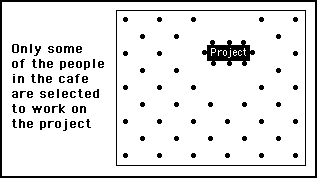
Figure 8.6
Simulation showing just a few of the people in the cafe would be involved in a project. These would be those whose skills set and knowledge were most appropriate.
When I saw this modification to the animation, I realised that the animation would more accurately reflect the dynamics of the cafe if it showed several different projects being worked on at the same time – with each project attracting a different group of people according their individual suitability and personal interests.
Dr. Thum duly modified the animation, as illustrated in figure 8.7, to show different projects appearing in the cafe space, which would attracted different people in the cafe.
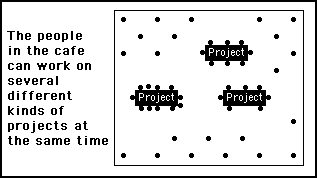
Figure 8.7
Illustrating how the cafe might be involved with several projects simultaneously, with the people in the cafe dividing up to work on different projects according to their capabilities and interests
After seeing Dr. Thum's new modification to the animation, I realised it still wasn't quite reflecting the way in which I was currently using the cafe. Perhaps it might work this way after I had identified and decided upon a few projects to definitely go for, but, at this moment in time I was still only investigating opportunities. The activity in the cafe was mostly in my mind.
Trying to set down on paper, how I was using the cafe to associate different people with different opportunities as they came along, I tried to analyse the mental processes I was using. I visualised how I'd think about who might be interested in working on an opportunity, who would have the necessary skill sets; who might have appropriate and relevant experience or knowledge. I'd look for knowledge gaps, needed skills, snags and pitfalls. I'd think about the possibilities of creating a profitable revenue stream, possibilities of funding; about the competition and possible alternatives.
There is nothing very precise of formal about this mental processing of opportunities. They are just quick assessments made to rapidly eliminate those opportunities that would obviously be non viable or too difficult to handle. I'd be looking for a match between a possible way to take advantage of the opportunity and the capabilities available in the cafe.
Very few of the many possible opportunities that occur pass this initial mental assessment, but, if one does, I identify who in the cafe might be needed to play a key part in bringing about a solution. I'd probably sound one or two of them out first, then, if they agreed on the potential of the opportunity, I'd get them into a discussion around a virtual table to explore the possibility of creating a business that could take advantage of that particular opportunity.
Seen in isolation, these opportunities and discussions can be rationally explained, but, they are not in isolation: many come along together. The activity is mainly instantaneous reactions to ideas and opportunities that seem to come along at random: most of which are quickly postponed or abandoned as flaws or snags were revealed. The more promising ideas or opportunities are investigated and developed further, giving them a longer life with different people involved in different aspects of the opportunities.
Dr Thum then redesigned the simulation to show opportunities coming in and out of existence for varying lengths of time. At each appearance of an opportunity, some of the dots would move towards it. The dots didn't always stay with an opportunity, they might only stay for a short time before moving on to another opportunity, maybe being replaced by other dots.
In this way, Dr. Thum simulated the cafe as a dynamic hive of activity as opportunities come and go and dots flit between them like a swarm of flies. A static illustration of this animation is shown in figure 8.8, but, it does small justice to the real activity that takes place – which goes on mostly in my head and opportunities seldom surviving long enough to involve actual interactive collaboration in the cafe.
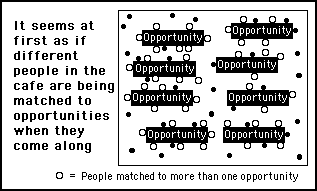
Figure 8.8
Illustrating the activity within a virtual cafe as opportunities appear at random. People are shown as being attracted to different opportunities, but, in actuality, much of this action only goes on inside the cafe owner's head as he or she visualises who might be suitable collaborators for any particular opportunity
After this further development of the animated simulation of the cafe, I still felt something was seriously wrong with this model. Something was missing because it still wasn't fully representative of the thinking and the actions I was currently taking in my efforts to create an e-business. What I was doing was involving far less change and mental activity than the model was suggesting. Paradoxically, there was much more stability and simplicity in the cafe I was using, yet, it was producing more complexity.
At the beginning of the chapter, I mentioned all the various e-business possibilities I was currently considering. These included: creating a database for medical treatments, developing an Internet course for school children, designing and selling intelligent agent software, providing Web site construction services, building a system of Asps (application service providers), forming a virtual social club, opening a penny bazaar, organising the servicing of aircraft... and many others besides. The situation can be represented as shown in figure 8.9.
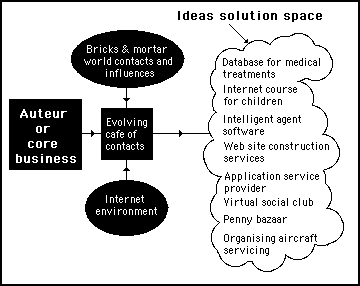
Figure 8.9
The ideas currently being considered at the start of this chapter which will be processed by means of the virtual cafe
Did I really have all these highly complex business possibilities under consideration at the same time? Each in their own right would require the whole of my thinking time, yet, I was seriously considering them all. How was I managing to do this and how was it represented in the animated simulation of the virtual cafe?
It then struck me that it wasn't detailed plans I was contemplating at all. I was considering a relatively small number of conceptual components. These components, in different combinations and applied in different ways, were yielding a large variety of possible scenarios, each of which appeared to be highly complex.
Then I had a thought: reconfiguring a number of basic components? Wasn't this the way Mother Nature created her stupendous array of different life forms? They aren't each individually designed. They are formed out of different combinations of discreet components. At the most basic level these components are genes, viruses and bacteria. These combine and interact in a variety of different ways to produce every life form on the planet. The human form contains something like 100,000 genes. They are not unique to humans, identical genes can be found in all kinds of different animals, even in plants and other kinds of living organisms.
At a level of organisation higher than the genetic level, there are combinations of genes that stay together to provide similar functions or structures in the physiology of a number of different species. These combinations of genes act as more complex components – which Mother Nature is using in different mixes to make all her insects, animals and plants.
From Mother Nature's point of view, she had evolved not complete life forms, but many different components that can be mixed and combined in a multitude of different ways. To her, the components are the more stable elements; the life forms are merely transitional arrangements that have little permanence or long term stability.
This throws a totally new light on the way to create e-businesses. The main concern isn't about looking for smart ideas or problems to solve: the primary objective is to build up a powerful set of components that can be applied to ideas and problems. The components are the main focus. The ideas, problems and opportunities are simply transient possible arrangements for the components at hand.
From this perspective, components must be created before any business ideas can be contemplated because they will determine what kind of e-business opportunity can be seized. To the world at large, this concern with components will seem like dancing around the fire, but, in reality it is the gathering together of a suitably large pool of genetic material.
This realisation also throws a completely different light on the cafe as it is being used to consider possible opportunities for an e-business. It isn't about a a collection of individuals, who have to be instructed what to do. Neither is it about bringing people together to join in a general brain storm to work out solutions to problems. It is about a collection of functions and services being provided by the people in the cafe. These provide conceptual building blocks, concepts from which e-business solutions can be created.
This different way of viewing a virtual cafe – when it is being used to search for a suitable e-business opportunity – is illustrated in figure 8.10.
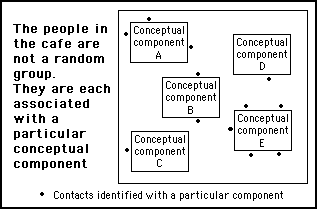
Figure 8.10
The people in the cafe are not there as isolated individuals with particular skills and knowledge. They have been selected because they are associated with the implementation of a particular conceptual component
This makes the cafe environment fundamentally different from most conventional business situations; the people in the cafe aren't there to be of service specifically to the auteur. They're there because they provide some essential function in a conceptual component – a component that might be needed in a dynamic system emerging as a response to an opportunity.
The people in the cafe wouldn't have to know how any particular system worked, or, even have to be concerned with its overall purpose. Their inclusion in any newly created system would involve doing little more than they would normally do – which is doing whatever it is they are good at doing.
Combining concepts and the people associated with them together as components allows a system builder to work above the level of technological detail. Although each component might be complex in itself, it can be treated much like a child might treat a component of a Lego set – the pieces can be fitted together to make a construction without having to be concerned about their composition or manufacture.
In this way, a system builder will be free to concentrate upon the overall behaviour of a system, mixing and matching components to quickly construct an e-business solution to any opportunity that presents itself. This is illustrated in figure 8.11, where the letters A, B, C, D, E, F, G represent seven conceptual components that are combined in different ways to provide a variety of solutions to a number of different opportunities.
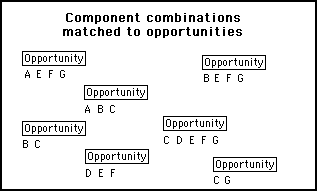
Figure 8.11
In the mind of the entrepreneur, it is the matching of conceptual components to an opportunity that is the main concern.